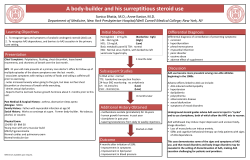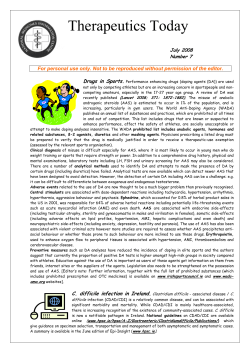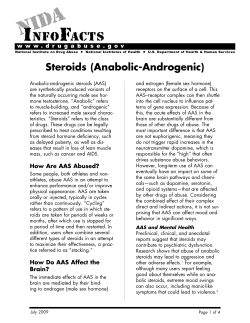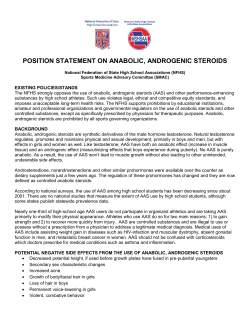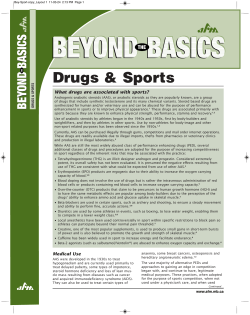
Risk Stratification by Autonomic Information Flow Characteristics
Risk Stratification by Autonomic Information Flow Characteristics D Hoyer1, B Frank1, PK Stein2, G Schmidt3, R Schneider3, H Schmidt4 1 Biomagnetic Center, Department of Neurology, Friedrich Schiller University, Jena, Germany 2 Washington University School of Medicine, St Louis, USA 3 1. Medizinische Klinik der Technischen Universität, München, Germany 4 University Department of Medicine III, Martin Luther University, Halle-Wittenberg, Germany organ object function of staying alive. Recently it was shown that specific prediction time intervals of the attractor are associated with specific mechanisms of the cardiovascular control system. The cardiovascular controller incorporates mechanisms at different time scales, such as the heart period (around 0.51 s), vagal (around 1-2 s), sympathetic (around 10 s), renin-angiotensin-aldosterone system (scale of minutes), renal volume pressure regulation (scale of hours), and circadian rhythm (which is present in all autonomic and humoral activities). Information flow measures, treated as functions of the time horizon of prediction (time scale of communication), can improve the assessment of particular aspects of complex cardiovascular mechanisms which themselves operate over different scales [1]. In several of our clinical studies it was confirmed that measures of AIF functions identified complex communication dysfunction at time scales according to the expectations from the pathophysiological point of view. Furthermore, these measures had significant predictive value. Both results hold for Multiple Organ Dysfunction Syndrome (MODS) patients [2], length of stay in hospital (LOS) of patients after abdominal aortic surgery (AAS) [3], and in patients after myocardial infarction (MI) [in prep.]. The objective of the present work was an evaluation of the association of AIF between different time scales. We investigated the hypothesis that there is a fundamental inverse relationship between alterations of the short term heart rate pattern and long term behavior. With this intention results of several of our clinical studies are reviewed and further analyzed. Abstract We investigated the hypothesis that Autonomic Information Flow (AIF) based predictors, reflecting short term and long term autonomic control, improve risk stratification in different clinical groups. The prognostic value of AIF measures was assessed in patients with multiple organ dysfunction syndrome MODS, after abdominal aorta surgery AAS, and after myocardial infarction MI in comparison to traditional HRV measures using ROC characteristics AUC(95%CI). Prognostic values were discriminated in MODS by AIF AUC=0.73(0.54,0.93) vs. TINN AUC=0.68(0.49, 0.90); after AAS with AIF AUC=0.73(0.62,0.84) vs. SDNNindex AUC=0.64(0.52,0.77); after MI AIF AUC=0.70(0.62, 0.77) vs. SDNN AUC=0.66(0.56, 0.74). We conclude that complex short term and long term cardiovascular control has an important prognostic value. 1. Introduction The understanding of the complex cardiovascular systems processing is still insufficient. On the one hand the identification of separate parts cannot explain the complex coordinated behavior. On the other hand the identification of complex systems behavior is basically limited concerning the identification of subsystems and needs adequate methods such as information and communication theory based approaches. Every control system must guarantee the stability of the closed-loop behavior. This theory is well established in the design of linear control systems. The theory fails in the case of complex and non-linear control systems. Instead, Lyapunov stability is usually used to study the behavior of those systems. The underlying hypothesis is that the system behaves within an attractor. In the case of the organism that attractor incorporates the multiple- ISSN 0276−6547 2. Methods The present study is based on the results of [2-4] where the details are outlined. 425 Computers in Cardiology 2006;33:425−428. 2.1. rhythm. Communication over one heart beat period might additionally indicate inherent cardiac behavior. Typical measures of the AIF over prominent prediction time horizons were assessed as short term measures, based on the average of short data windows as well as long term measures based on the entire data set as follows: Patients - Patients with MODS (26 survivors, 10 non-survivors, 28 day mortality) - Patients after AAS (32 length of stay (LOS) > 7 days, 62 LOS 7 days)) - Patients after MI (1221 survivors, 55 non-survivors) 2.2.1.1. Short term measures In all groups 24 h Holter recordings were analyzed using AIF methodology according to the HRV Task Force guidelines [2-5]. 2.2. DECR1: AIF decay over v=0.6 s (v standard beat period in all studies presented here, in bit/s, normalized). This measure is the mean of all 30 min segments based on non-filtered time series resampled at 5 Hz. Autonomic information flow (AIF) Information flow characterizes communication within a time series in terms of information transfer over a prediction time horizon v. It measures the average information of the time shifted signal X(t+v) which is already contained in the signal X(t). This autonomic information flow (AIF) function is assessed based on the Shannon entropy H X ? /Â pi log 2 pi DECHF, DECLF, DECVLF: AIF decay over periods related to the standard frequency band boundaries (HF: v=1.25-3.33 s, LF: v=3.33-12.5s, VLF: v=12.5-166.7 s) (in bit/s normalized). These measures are the mean of all 5 min (HF), 5 min (LF), 30 min (VLF) segments, respectively, based on filtered (HF, LF, VLF, respectively) time series. (1) i 2.2.1.2. Long term measures applied to the original time series X(t), leading to HX(t); the part X(t+k) shifted by time lag k, leading to HX(t+k); and a bivariate presentation, leading to H[X(t), X(t+k)], as AIF[X(t),X(t - k)] ? H X(t) - H X(t - k) / H[X(t), X(t - k)] . DEClong : AIF decay over v=100 s. This measure reflects the complex communication involving long term mechanisms based on the nonfiltered entire data set. (2) The information flow over particular time horizons v allows the identification of particular physiological oscillators [1]. The information loss is related to complexity measures [1]. We developed AIF measures based on NN interval series from resampled time series, corresponding to conventional HRV Task Force guidelines [5], completely introduced in [2-4] 2.3. Statistical analysis The comparison between patients and controls, as well as between high risk and low risk groups, were done by means of the receiver operating curve (ROC) characteristics; pairs of true and false positives for the prediction of prognosis group were estimated over the full range of possible cut-off values. The area under the ROC curve (AUC) of 1 is associated with perfect classification, and AUC of 0.5 corresponds to a random assignment of patients by prognosis group. Significantly discrimination was considered to exist if the lower bound of the twosided 95%-confidence interval (CI) of the respective AUC was >0.5. 2.2.1. AIF measures AIF functions were estimated according to the short and long term approaches of the linear measures of Task Force HRV [5]. HRV at short time scales has been clearly related to autonomic mechanisms as follows: HF (high frequency power) mainly reflects vagal modulation of HR; LF (low frequency power) reflects sympathetic and parasympathetic modulation; the physiological basis of VLF (very low frequency power) is inconsistently reported, but a clear parasympathetic influence has been confirmed [6]; long term communication reflects slower fluctuations with high amplitudes mainly circadian 3. Results The significant AUC risk predictors (lower CI of AUC > 0.5) are organized in Table 1 in dependence on the time 426 horizon of the AIF functions. Each patients group show specific predictors. In the MODS patients the vagal time scale information flow (HF) is predominantly reduced in the higher risk group (longer LOS). A clear discrimination between vagal and sympathetic parts in the LF band is basically not possible. This result indicates a reduced systematic vagal control to be a risk index. After AAS longer stay in hospital is associated with reduced loss of information over longer time scales. This result indicates reduced integrative complex control within the entire cardiovascular system. Higher mortality after MI is associated with increased loss of information over the time scale of one heart beat in connection with reduced long term information loss. This short term behavior indicates a loss of systematic control and increased randomness in the cardiac inherent operating of the non-survivors. It should be emphasized that the long term cardiovascular control shows the opposite differences of the AIF characteristics. Table 2: ROC curve discrimination results by AIF measures versus best HRV measure 4. Table 1: Significant AIF risk predictors Time scale AIF measures short-term long R1 HF LF VLF DEC DEC DEC DEC - - MODS: LET < 28 d vs. LET 28d - AAS: LOS > 7 d vs. LOS 7 d - - AUC(95% CI) MODS TINN AIFrisk 0.68(0.49, 0.90) 0.73(0.54, 0.93) AAS SDNNindex AIFrisk 0.64(0.52, 0.77) 0.73(0.62, 0.84) MI SDNN AIFrisk 0.66(0.56, 0.74) 0.70(0.62, 0.77) Discussion and conclusions Measures of heart rate fluctuations have been accepted as prognostic values in diseases influencing cardiovascular control. But, due to the high complexity of the cardiovascular system, traditional Task Force HRV measures are insufficient to assess the co-ordination between different control mechanisms acting on different time scales. In those cases, communication measures such as autonomic information flow (AIF) may be preferable. We investigated the hypothesis that AIF based predictors, reflecting short term and long term autonomic control, improve risk stratification in different clinical groups. In MODS the prognostic value of the reduced vagal information flow (increased DECHF) was similar to that of the APACHE II score, the clinical gold standard [2]. The development of MODS is associated with an inappropriate release of inflammatory mediators leading to cell damages of parenchymal organs and to inflammatory, metabolic, and neuro-endocrine disturbances. An intact parasympathetic activity seems to be a precondition to suppress the overwhelming inflammatory response in MODS and it was described as part of an anti-inflammatory control loop. As a therapeutic consequence vagus stimulation is discussed [7-9]. Vagal time scale related AIF may be able to monitor this essential prognostic aspect. After AAS, where the heart is not affected, the cardiac cycle information flow (DECR1) is not altered. The loss of complex cardiovascular control is reflected in the integrative longer term predictors DECVLF and DEClong. The quality of restoring the complex cardiovascular control seems to be reflected by this communication long DEC Measure - MI: non-survivors vs. survivors The prognostic value of the AIF risk predictors from Table 1 in comparison to the best traditional HRV measure of each patients group is shown in Table 2. 427 measure with predictive value. After MI the cardiac excitation cycle is pathologically altered and destabilized, leading to randomized cardiac inherent information flow (increased DECR1). This disturbance over the cardiac horizon (attractor divergence over 0.6 s) was associated with a reduced complex control (simplification) over the long term horizon (reduced DEClong, attractor with reduced divergence over 100 s). The heart acts as common actuator of different control loops. Therefore heart rate patterns reflect the complex cardiovascular control. Pathophysiological disturbances of the heart rate pattern can be situated within cardiac processes as well as in the variety of neuro-vegetative (autonomic) and humoral regulatory processes. Their complex interplay seems to be represented better by AIF characteristics, which allow the assessment of complex coordinations, than by standard time and frequency domain HRV measures, which are mainly based on linear superposition of rhythms. Also the widely used single scale complexity measures can basically not identify particular control mechanisms based on there time scales. Therefore, multi-scale approaches such as multi scale entropy (MSE) and detrented fluctuation analysis (DFA) are fundamentally predestinated as potential risk predictors besides AIF. The advantage of AIF functions is that they can be focused on the time scales of particular physiological mechanisms. This approach was developed and validated by animal models with well defined alterations of the autonomic nervous systems and mathematical simulations [1] before starting several clinical studies, e.g. [2-4]. In that way, from the medical point of view more specific and interpretable risk predictors were developed. AIF functions improve the understanding of complex cardiovascular and related processes and might be useful for the development of comprehensive therapeutic strategies. References [1] Hoyer D, Pompe B, Chon KH, Hardraht H, et al. Mutual information function assesses autonomic information flow of heart rate dynamics at different time scales. IEEE Trans Biomed Eng 2005;52:584-592. [2] Hoyer D, Friedrich H, Zwiener U, Pompe B, et al. Prognostic impact of autonomic information flow in multiple organ dysfunction syndrome patients. International Journal of Cardiology 2006;108:359-369. [3] Hoyer D, Friedrich H, Stein PK, Domitrovich PP, Buchman TG. Autonomic Information Flow improves prognostic value of heart rate pattern after abdominal aortic surgery. Journal of Critical Care 2006; (in revision). [4] Hoyer D, Friedrich H, Frank B, Pompe B, et al. Autonomic information flow improves prognostic impact of task force HRV monitoring. Computer Methods and Programs in Biomedicine 2006;81:246-255. [5] Task Force of the European Society of Cardiology and the North American Society of Pacing and Electrophysiology. Heart rate variability, standards of measurement, physiological interpretation and clinical use. Circulation 1996;93:1043-1065. [6] Taylor JA, Carr DL, Myers CW, Dwain BS, Eckberg L. Mechanisms underlying very-low-frequency RR-interval oscillations in humans. Circulation 1998;98:547-555. [7] Borovikova JV, Ivanova S, Zhang M, Yang M, et al. Vagus nerve stimulation attenuates the systemic inflammatory response to endotoxin. Nature 2000;405:458-62. [8] Tracey KJ. The inflammatory reflex. Nature 2002;420: 853-859. [9] Libert C. Inflammation: A nervous connection. Nature 2003;421:328-329. Address for correspondence Dirk Hoyer, PhD Biomagnetic Center, Department of Neurology Friedrich Schiller University Erlanger Allee 101 07747 Jena Germany dirk.hoyer@biomag.uni-jena.de Acknowledgements This work was supported by DFG (Ho1634/8-1,2 and Ho1634/9-1,2). 428
© Copyright 2025












